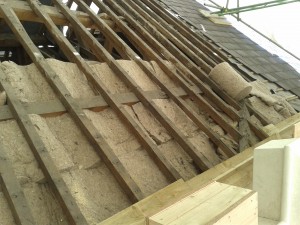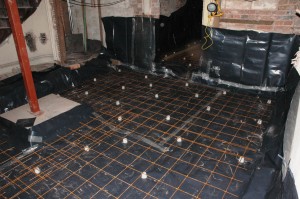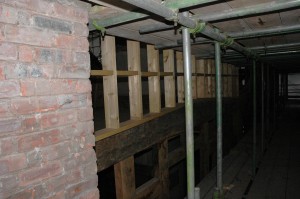Of all the crafts which have been involved in the restoration of the Abbey, perhaps the most intricate has been the work of paintings conservation. This has been undertaken by Harriet Owen Hughes at The Conservation Centre in Liverpool, which is part of the National Museums Liverpool.
Harriet first worked on a painting from Combermere several years ago, and conserved the four Tudor portraits from the fire surround in The Library six years ago. Of these portraits she says that she found the royal portraits to be “set pieces”, that is to say replicas of existing images of Henry and Elizabeth. Both monarchs were keen that their image should be seen throughout the land and many copies were made of portraits for which they had actually sat. On the other and the portrait of Richard Cotton’s son and heir, George, was far more interesting, “He looked much more like a real person. The others had been messed about with; that one is the most genuine”, she says. You can read more about these portraits by clicking here. The fire surround portraits were conserved with the help of a grant from the Heritage Conservation Trust.
The painting of Elizabeth had been ‘updated’ at least once, it seemed, possibly once in the reign of Queen Anne, to make the Tudor monarch look more contemporary; indeed, possibly to make her look like Queen Anne. There was “something else” under Elizabeth I’s ruff, Harriet thought, but it did not show up in x-rays, and it was probably a completely different ruff (and a different dead dress). It would have been wrong to take the restoration any further back. “I would have liked to have got the dendrochronology man in and have dated the wood on which the portraits were painted, but in fact we couldn’t, which was a shame – so we can’t be entirely sure that they were contemporaneous with the re-building of the house”.
The most recent project which Harriet has undertaken for the Abbey was the large bird’s-eye view of the estate by Tillemans, painted in 1730, and the larger and later portraits from the Library. The Tillemans painting was worked on in Harriet’s studio from October 2014 until that Christmas. You can see more about the Tillemans and its restoration by clicking here.
One portrait, an almost-full-size painting of a mid-Seventeenth century gentleman in armour, was found to have been extended downwards at some point. The legs were not there originally, and a panel had been attached for their creation, but what was really surprising was that, under the latter paint, there had been a much earlier and rather good painting of some flowers. This panel had been attached upside down. A decision was made to conserve the flowers around his armoured legs so that he now stands in an herbaceous border, which is rather curious but does give us the best of both worlds.
That portrait, and one of a continental – possibly Dutch or German – lady were in poor repair, and Harriet thinks that they might previously have been heavily restored after a fire, or some similar major catastrophe.
One problem encountered on a number of the Combermere paintings, and apparently a very common one, was that they had been over-cleaned in the past – often on more than one occasion – and then there was too much over-painting, creating headaches for later conservators; “Any re-touching I have done is made up of a mixture of pigments and varnish, so in the future it can be taken off as easily as taking off varnish. We are very particular about varnish; we make our own from resin. It doesn’t go yellow and it is reversible.”
Harriet began her career by studying Art History at the Courtauld Institute, (where her tutors included Sir Anthony Blunt, who was later exposed as a Soviet spy, and was stripped of his knighthood) and then took a two-year course in conservation in the same building. She moved to Liverpool when she married and worked at the Walker Art Gallery, before setting up her own conservation studio in the Bluecoat Chambers in the city.
The facilities in her current studio at the Conservation Centre, where she has now been for fifteen years, are world class, she says. The Centre was opened by Prince Charles some twenty years ago, but in recent years it has been hard hit by cuts in funding.
We are very grateful to Harriet for her superb work in giving new life to all the Abbey paintings she has worked on.
You can read more about the portraits in The Library and the restoration story by clicking here.
























